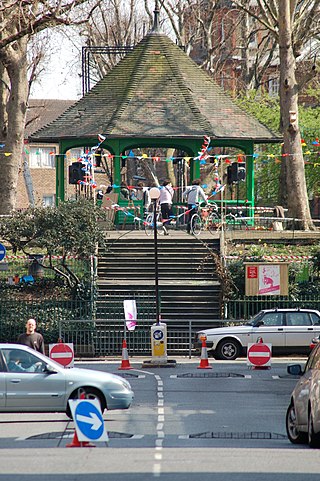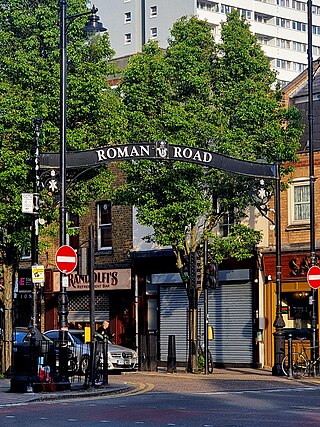
Bethnal Green is an area in London, England and is located in the London Borough of Tower Hamlets. It is in east London and part of the East End. The area emerged from the small settlement which developed around the Green, much of which survives today as Bethnal Green Gardens, beside Cambridge Heath Road. By the 16th century the term applied to a wider rural area, the Hamlet of Bethnal Green, which subsequently became a Parish, then a Metropolitan Borough before merging with neighbouring areas to become the north-western part of the new Tower Hamlets.

Bethnal Green was a civil parish and a metropolitan borough of the County of London between 1899 and 1965, when it was merged with the Metropolitan Borough of Stepney and the Metropolitan Borough of Poplar to form the London Borough of Tower Hamlets.

Bow is a district in East London, England and is in the London Borough of Tower Hamlets. It is an inner-city suburb located 4.6 miles (7.4 km) east of Charing Cross.

Old Ford is an area in the London Borough of Tower Hamlets that is named after the natural ford which provided a crossing of the River Lea.

The London Buddhist Centre (LBC) is a temple located on Roman Road, Bethnal Green, London, that serves as the main base for the London Triratna Buddhist Community. It opened in 1978 in a ornate, vernacular redbrick former Victorian fire station that was completed in 1888, and in use by the London Fire Brigade until 1969. The building was fire-damaged in the 1970s, before being renovated by volunteers for its current use. Further major improvements were completed in 2009.

Hackney Road is a London arterial route running from Shoreditch Church in London Borough of Hackney to Cambridge Heath in the London Borough of Tower Hamlets. The route runs along the northern edge of Bethnal Green and southern edge of Haggerston. It lies close to the border between the boroughs of London Boroughs of Hackney and Tower Hamlets.

The Boundary Estate is a housing development in the London Borough of Tower Hamlets, in the East End of London.

Arbour Square is a late Georgian square in Stepney, in the borough of Tower Hamlets, east London, England.

Tower Hamlets London Borough Council, also known as Tower Hamlets Council, is the local authority for the London Borough of Tower Hamlets in Greater London, England. It is a London borough council, one of 32 in London. The council has been under the majority control of local party Aspire since 2022. It has been led by a directly elected mayor since 2010. The council is based at Tower Hamlets Town Hall on Whitechapel Road.

Lichfield Court, on Sheen Road in Richmond, London, consists of two Grade II listed purpose-built blocks of flats. Designed by Bertram Carter and built in fine Streamline Moderne style, it was completed in 1935.

The Cranbrook Estate is a housing estate in Bethnal Green, London, England. It is located next to Roman Road and is based around a figure of eight street called Mace Street. The estate was designed by Francis Skinner, Douglas Bailey and an elder mentor, the Soviet émigré Berthold Lubetkin.

St James-the-Less is a church in Bethnal Green, London, England. It is an Anglican church in the Diocese of London. The church is in the London Borough of Tower Hamlets. Prior to 1965 it was in the Metropolitan Borough of Bethnal Green.

St Peter's Bethnal Green is a 19th-century church in Bethnal Green, London, England.

Roman Road is a road in East London, England, in the London Borough of Tower Hamlets entirely on the B119 on the B roads network. It lies on the old Roman Pye Road of the Roman Empire running from the capital of the Iceni at Venta Icenorum to Londinium and today hosts a street market. Beginning in Old Ford at its eastern end, it passes into Bethnal Green to its western end.

The Royal Oak is a Grade II listed public house at 73 Columbia Road, Bethnal Green, London, E2.

The Commercial Tavern is a pub at 142 Commercial Street, Spitalfields, in the London Borough of Tower Hamlets.

The Duke of Wellington is a former pub at 52 Cyprus Street, Bethnal Green, London E2.

Mulberry Place, formerly Tower Hamlets Town Hall, is a building in Nutmeg Lane, Blackwall, London. It was the headquarters of Tower Hamlets London Borough Council from 1992 to 2023, before their relocation to the new Tower Hamlets Town Hall in Whitechapel Road.

Bethnal Green Town Hall is a former municipal building on the corner of Cambridge Heath Road and Patriot Square in Bethnal Green, London. It is a Grade II listed building.

John Dixon Butler was a British architect and surveyor who had a long, professional association with London's Metropolitan Police. During his 25-year career with the police, he completed the designs and alterations to around 200 police buildings, including ten courts; as of 2022, about 58 of his buildings survive. Historic England describes him as "one of the most accomplished Metropolitan Police architects" and have included around 25 of his buildings on the National Historic List of England and Wales.



















